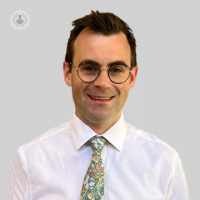Gynaecomastia: a comprehensive overview
Written by:Find out all about gynaecomastia in this article below, as revered consultant plastic, reconstructive, and hand surgeon, Mr Alexander Armstrong, provides us with an informative guide on the condition.

What is gynaecomastia?
Gynaecomastia is a combination of excess breast tissue, fat, and skin that can affect some males. It can occur after massive weight loss, where the skin does not retract and continues to sag.
What is gynaecomastia (male breast reduction) surgery?
There are various different surgical techniques available to correct gynaecomastia. Techniques can often be combined with liposuction to address excess fat. The main surgical interventions include:
- Liposuction
- Excision of the breast gland
- Excision of excess skin
- Combination of procedures above
How can I help my operation be a success?
It is important to keep your weight steady with a good diet and regular exercise leading up to gynaecomastia surgery. If you smoke, stopping at least six weeks before the operation will help to reduce the risk of complications.
What should I expect after the operation?
Gynaecomastia surgery is usually carried out under a general anaesthetic. Smaller cases can be performed under local anaesthesia. The operation usually takes between one to three hours.
When you wake up from your operation, you may have a drip to give you fluid while you are not drinking. You might be given antibiotics to keep the wound clean. Also, you may have drainage tubes in your chest to drain away any fluid or blood. These tubes will be taken out when the fluid or blood has stopped draining, usually before you go home. Your chest will feel swollen and sore. Simple painkillers should be enough to keep you comfortable.
What is recovery from gynaecomastia surgery like?
You will be out of bed on the same day as your surgery and doing light activities after two weeks. You should be back to normal exercise between four to six weeks, depending on the type of procedure you have had.
You should avoid strenuous activity for four to six weeks. Most patients take two to four weeks off work after the operation. Your chest will be uncomfortable and swollen for weeks to months after the operation.
In terms of results, what can I expect?
Initially, your chest skin will feel swollen and tight. This usually settles down within six weeks of the surgery. Most patients are pleased with the final result, but some find their new shape difficult to get used to.
You may have more or less sensation in the skin on your chest, and this can change over time. Your nipple may become over or under sensitive after surgery. If you have a free nipple graft, you are unlikely to recover any significant sensation to your nipple.
If you’d like to consult with Mr Alexander Armstrong, head on over to his Top Doctors profile today.


